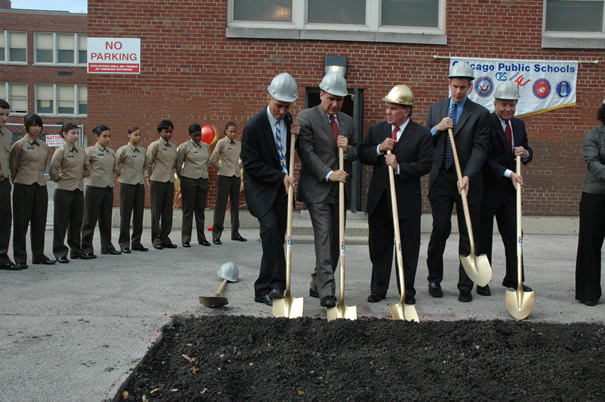Part 2 - The First Test - The Bloody Birth of the Counterrevolution
Counterrevolution began 34 years ago in Chile on another September 11 that should have been unimaginable and had to seem surreal. There were tanks in the streets and fighter jets attacking government buildings in a scene all too real and deadly. It played out in Santiago and around Chile and was just the beginning of a long nightmare. It brought General Augusto Pinochet to power (with plenty of CIA help) who called his action “a war,” not a coup, and to reinforce his message he made it seem like one. Blood in the streets, the presidential palace in flames, and 
A state of siege was imposed followed by mass arrests, killings and torture in a climate of fear that enveloped the country. Allende supporters were targeted in Chile’s “Caravan of Death.” Chileans paid dearly, but the Chicago Boys had their moment of triumph, and they were ready. Rolling off the press was their detailed economic manual for the new government called “The Brick.” It was a 500-page Chicago School shock therapy wish list. It was “the first Chicago School state,” its first “global counterrevolution” victory, and “a genesis of terror” in a brave new world for Chileans.
The economic playbook was right from Milton Friedman’s “Capitalism and Freedom” that’s long on free market triumphalism and void on its effects on real people. It was pure Friedman featuring mass privatizations, deregulation and deep social spending cuts flavored generously with corporate-friendly tax cuts, trade unionist crackdowns, savage repression for non-believers, and an end to Chile’s social democratic state Friedman condemned.
Pinochet bought it along with a team of Chicago School alumni called “technos.” They embarked on a free market binge with disastrous results. In the first year, inflation hit 375 percent, thousands of Chileans lost jobs, the country was flooded with cheap imports, local businesses closed and hunger grew along with public and small business discontent in this free market “paradise.” In desperation, “it was time to call in the big guns” with Milton Friedman coming to Santiago to reinforce his message that for things to improve they first had to get worse. It was classic shock treatment and Chicago School baloney with Friedman preaching patience and promising an “economic miracle” if his prescription was followed.
Pinochet agreed, and slash and burn followed with visions of paradise at the end of the rainbow. It was pure untested fantasy, and the results showed it. After one year of hardened shock therapy, Chile’s economy contracted 15 percent, unemployment rocketed to 20 percent, and contrary to Friedman’s rosy scenario it lasted for years with no social safety net help for desperate Chileans.
Klein notes Chile today is still cited as a model that free market “Friedmanism” works in spite of the clear evidence it doesn’t. Growth did resume a decade later, but only after conditions worsened. It forced Pinochet to reinstate Allende policies like renationalizing privatized companies but not his social democratic agenda. Chileans were left with the shambles. When the economy stabilized and rapid growth resumed in the late 80s, poverty was 45 percent, but the richest 10 percent saw their incomes rise by 83 percent. Even today, Klein notes, Chile remains one of the most unequal societies in the world. It’s shock therapy miracle shifted “wealth to the top and shock(ed) much of the middle class out of existence.”
It’s the way it works everywhere and a glimpse of the future: “an urban bubble of frenetic speculation and dubious accounting fueling super-profits and frantic consumerism, ringed by ghostly factories and rotting infrastructure of a development past; roughly half the population (excluded); out-of-control corruption and cronyism; (decimated) nationally owned small and medium-sized businesses; (mass) transfer of (public) wealth (and resources) to private hands (accompanied by) a huge (shift) of private debts into public hands.” Inside the Chilean bubble was paradise. Outside was “The Great Depression.” Bubble-benefitters reacted with “junkie logic: Where is the next fix?”
It was first across the border in other Latin American Southern Cone countries where the “counterrevolution spread (and) people vanish(ed).” Argentina, Brazil and Uruguay were targeted with similar results as in Chile under juntas replacing democrats. Chicago School fundamentalism was on a roll, and woe to the non-believers. Nations that were developmentalism models became wastelands with decades of worker gains lost almost overnight. Factories closed, wages fell, unemployment soared, poverty grew severe, dissenters disappeared, and ordinary people suffered to prove what pin-stripped academics knew after Chile went sour. Instead, it was on to the next target.
In them all, the slate was cleansed and terror unleashed, unrestrained by national borders. Former Allende economist and diplomat turned activist Marcos Orlando Letelier became a victim in September, 1976. While living in Washington, he condemned Chile’s “economic freedom” for the privileged and paid with his life. Pinochet’s DINA secret police killed him and his American colleague, Ronni Moffit, by remote-detonating a bomb planted under his driver’s seat. An FBI investigation learned the assassins entered the country under false passports with full CIA knowledge and complicity.
The purging included cleansing wrong ideas and thinkers like legendary left wing Chilean folk singer, Victor Jara. He was seized and taken to Chile’s notorious National (killing and torture) Stadium to be reeducated. Soldiers broke his hands so he couldn’t play the guitar. Then they shot him 44 times “to make sure he couldn’t inspire from....the grave.” One culture was being erased and replaced by another. As in Nazi Germany, books were burned, newspapers and magazines shuttered, universities occupied and strikes and political meetings banned. Trade unionists were specially targeted as threats to the new economic order. It’s leaders were rounded up, movement members viciously attacked, and “battalions” targeted workers in factories. They were arrested, imprisoned, tortured, and disappeared in a sweeping reign of terror designed to crush opposition and wrong-thinking.
In Argentina, Ford Motor Company’s local subsidiary was complicit. It helped soldiers and secret police rid unionists from its factories and supplied vehicles as well. Green Ford Falcon sedans became the feared symbol of terror an Argentine playwright called “death-mobiles.” Many thousands kidnapped and disappeared rode off in these cars, never to return.
Farmers involved in land reform struggles also were targeted along with anyone with “a vision of society built on values other than pure profit.” It affected community worker activists, many church-connected, who wanted social services like health care, public housing and education the state was erasing through shock therapy and mass repression. Klein noted while “policies attempted to excise collectivism from the culture, inside....prisons (the practice was to) excise it from the mind and spirit.” The sickness was democratic socialism, the cure pain and suffering. Wrong-thinkers were taught the hard way, and many paid with their lives. Chicago School fundamentalism is harsh medicine. Its grand guru, Milton Friedman, was unrepentant. He called it “freedom” and took his mathematical model miracle to the grave amidst a hail of undeserved eulogies.
In his memoirs before he died, his “blatant revisionism” on Chile was shameful and disturbing. He falsely claimed Pinochet only asked for help in 1975 when, in fact, the Chicago Boys worked with the military before the 1973 coup, and their policies were implemented on Pinochet’s first day in power. Friedman also claimed the junta’s repressive years didn’t undo Chilean democracy. In his view, it opened up “more room for individual initiative and for a private sphere of life (offering a greater) chance of a return to a democratic society.” It was classic convoluted Chicago School thinking. It made him famous courtesy of corporate triumphalism, generous funding and an utter disdain for human rights and dignity.
Friedman also used his 1976 Nobel lecture to argue economics was as scientifically accurate and objective as other sciences. He failed to mention its dark side - devastating poverty, unemployment, shuttered factories and mass human misery and deaths in the first nation adopting his ideology on its victimized people. Now it’s everywhere and savagely enforced in an age of corporate dominance, wars for profit and neglect of human needs to fund them. That’s Friedman’s real legacy from the barrel of a gun and called “freedom.”


